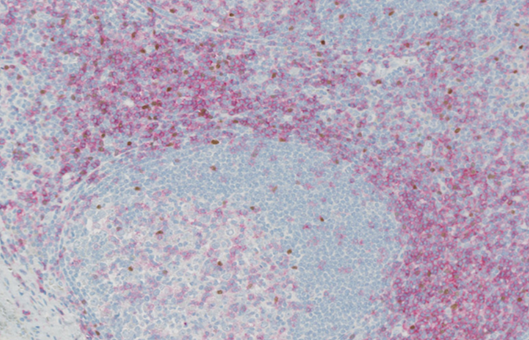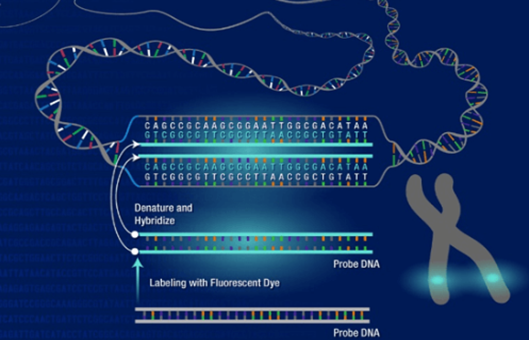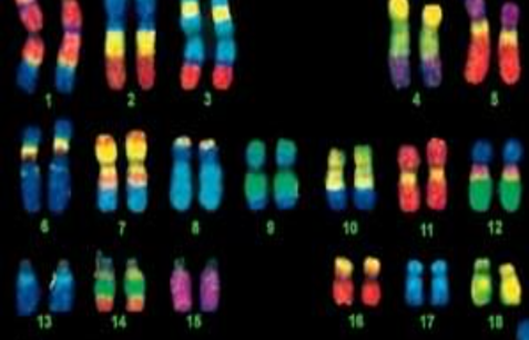Validation of Dual-Color Dual ISH for HER2/neu Gene in Breast Cancer
Archives of Pathology & Laboratory Medicine. 2024 Apr 1; 148 (4): 453-460.
Authors: Rathi A, Sahay A, Shet TM, Patil A, Desai SB.
INTRODUCTION
Human epidermal growth factor (HER2/neu) gene amplification, a poor prognostic factor in invasive breast cancer, has shown substantial utility as a predictive marker, with significantly improved survival following anti-HER2 therapies like trastuzumab. Dual-color dual in situ hybridization (D-DISH), a recently introduced fully automated assay for HER2/neu evaluation on light microscopy, has several advantages over fluorescence in situ hybridization (FISH).
METHODS
- HER2/neu IHC was performed on formalin-fixed, paraffin-embedded tissue on a fully automated platform with anti-HER2/neu antibody. D-DISH was performed using the HER2 dual ISH DNA probe in 148 cases of invasive breast cancer. The same block was used for performing immunohistochemistry by anti-HER2/neu (4B5) antibody and FISH assay by ERBB2/CEN17 dual color probe. D-DISH was separately interpreted by 4 pathologists blinded to FISH results.
- Browse our recommendations
| Product/Service Types | Description |
| Immunohistochemistry (IHC), Immunofluorescence (IF) Service | Creative Bioarray offers the best immunohistochemistry and immunofluorescence service. |
| In Situ Hybridization (ISH) & RNAscope Service | Creative Bioarray provides ISH services using fluorescence or bright fields. |
| Fluorescent In Situ Hybridization (FISH) Service | Creative Bioarray offers a full line of FISH services, from standardized testing of validated assays to custom development of new assays. |
| ISH/FISH Probes | Creative Bioarray provides the most comprehensive list of FISH probes for rapid identification of a wide range of chromosomal aberrations across the genome. |
| IHC ISH Reagents | With a strong focus on innovative solutions, Creative Bioarray specializes in the development and production of high-quality reagents for IHC and ISH applications. |
RESULTS
- Of 148 cases, FISH showed nonamplified HER2 in 93 (62.8%) and amplified HER2 in 55 (37.2%). 54 of 148 cases (36.4%) belonged to group 1 and 88 cases (59.4%) belonged to group 5. Only 2 cases (1.35%) were categorized in group 2 and were nonamplified, and none of the cases belonged to group 3. Four cases (2.7%) fell into group 4; of these, 3 were labeled nonamplified and 1 amplified after taking into consideration FISH and IHC profiles.
- D-DISH showed HER2 amplification in 53 cases (35.8%), whereas 95 of 148 (64.1%) were nonamplified. All cases nonamplified on FISH were nonamplified on D-DISH as well (93 of 93; 100%). Of the 55 cases amplified on FISH, 53 were amplified on D-DISH (96.3%), whereas 2 cases were nonamplified.
- A concordance rate of 98.65% and a Cohen κ statistic value of 0.97 (95% CI, 0.95-0.99) were observed between FISH and D-DISH, translating to almost perfect agreement between the 2 tests. Additionally, D-DISH showed very high sensitivity, specificity, positive predictive value, and negative predictive value compared with FISH. ICC values denoted excellent agreement in measuring HER2 signals, CEP17 signals, and HER2: CEP17 ratio for HER2 evaluation between the 2 methods.
![A case with HER2/neu immunohistochemistry (IHC) score 1+ (A), nonamplified on both fluorescence in situ hybridization (FISH) (B) and dual-color dual in situ hybridization (D-DISH) (C). A case with HER2/neu IHC score 3+ (D), amplified on both FISH (E) and D-DISH (F) (original magnifications ×400 [A and D], ×1000 [B and E], and ×600 [C and F]).](/upload/image/3-validation-of-dual-color-dual-ish-for-her2-neu-gene-in-breast-cancer-1.jpg) Fig. 1 A case with HER2/neu immunohistochemistry (IHC) score 1+ (A), nonamplified on both fluorescence in situ hybridization (FISH) (B) and dual-color dual in situ hybridization (D-DISH) (C). A case with HER2/neu IHC score 3+ (D), amplified on both FISH (E) and D-DISH (F) (original magnifications ×400 [A and D], ×1000 [B and E], and ×600 [C and F]).
Fig. 1 A case with HER2/neu immunohistochemistry (IHC) score 1+ (A), nonamplified on both fluorescence in situ hybridization (FISH) (B) and dual-color dual in situ hybridization (D-DISH) (C). A case with HER2/neu IHC score 3+ (D), amplified on both FISH (E) and D-DISH (F) (original magnifications ×400 [A and D], ×1000 [B and E], and ×600 [C and F]).
![A case with HER2/neu immunohistochemistry (IHC) score 2+ (A), nonamplified on both fluorescence in situ hybridization (FISH) (B) and dual-color dual in situ hybridization (D-DISH) (C). A case with HER2/neu IHC score 3+ (D), amplified on both FISH (E) and D-DISH (F) (original magnifications ×400 [A and D], ×1000 [B and E], and ×600 [C and F]).](/upload/image/3-validation-of-dual-color-dual-ish-for-her2-neu-gene-in-breast-cancer-2.jpg) Fig. 2 A case with HER2/neu immunohistochemistry (IHC) score 2+ (A), nonamplified on both fluorescence in situ hybridization (FISH) (B) and dual-color dual in situ hybridization (D-DISH) (C). A case with HER2/neu IHC score 3+ (D), amplified on both FISH (E) and D-DISH (F) (original magnifications ×400 [A and D], ×1000 [B and E], and ×600 [C and F]).
Fig. 2 A case with HER2/neu immunohistochemistry (IHC) score 2+ (A), nonamplified on both fluorescence in situ hybridization (FISH) (B) and dual-color dual in situ hybridization (D-DISH) (C). A case with HER2/neu IHC score 3+ (D), amplified on both FISH (E) and D-DISH (F) (original magnifications ×400 [A and D], ×1000 [B and E], and ×600 [C and F]).
![A discrepant case with HER2/neu immunohistochemistry (IHC) score 3+ (A), amplified on fluorescence in situ hybridization (FISH) (B) but nonamplified on dual-color dual in situ hybridization (D-DISH) (C). Another discrepant case with HER2/neu IHC score 2+ with heterogeneity (D), amplified on FISH (E) but nonamplified with intermixed heterogeneity and focal black dust on D-DISH (F) (original magnifications ×400 [A and D], ×1000 [B and E], and ×600 [C and F]).](/upload/image/3-validation-of-dual-color-dual-ish-for-her2-neu-gene-in-breast-cancer-3.jpg) Fig. 3 A discrepant case with HER2/neu immunohistochemistry (IHC) score 3+ (A), amplified on fluorescence in situ hybridization (FISH) (B) but nonamplified on dual-color dual in situ hybridization (D-DISH) (C). Another discrepant case with HER2/neu IHC score 2+ with heterogeneity (D), amplified on FISH (E) but nonamplified with intermixed heterogeneity and focal black dust on D-DISH (F) (original magnifications ×400 [A and D], ×1000 [B and E], and ×600 [C and F]).
Fig. 3 A discrepant case with HER2/neu immunohistochemistry (IHC) score 3+ (A), amplified on fluorescence in situ hybridization (FISH) (B) but nonamplified on dual-color dual in situ hybridization (D-DISH) (C). Another discrepant case with HER2/neu IHC score 2+ with heterogeneity (D), amplified on FISH (E) but nonamplified with intermixed heterogeneity and focal black dust on D-DISH (F) (original magnifications ×400 [A and D], ×1000 [B and E], and ×600 [C and F]).
SUMMARY
IHC, FISH, and D-DISH were analyzed for 148 IBC cases, of which 35 (23.6%) had a score of 0/1+, 74 (50%) had a score of 2+, and 39 (26.4%) had a score of 3+ on IHC for HER2. The study successfully validated the latest version of the D-DISH assay as a substitute for FISH in predicting HER2 gene status with significant interobserver reproducibility, concluding that this D-DISH assay may be introduced in routine diagnostic services as a reflex test to ascertain HER2 gene status.
RELATED PRODUCTS & SERVICES
Reference
- Rathi A, et al. (2024). "Validation of Dual-Color Dual In Situ Hybridization for HER2/neu Gene in Breast Cancer." Arch Pathol Lab Med. 148 (4): 453-460.


